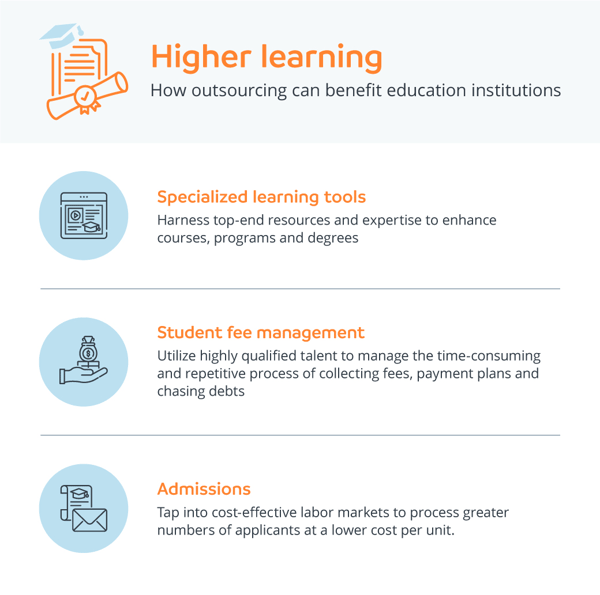The complete guide to outsourcing in education services
When future historians reflect on the pandemic that swept the world in 2020, there is little doubt they will ask serious questions about the response from the education sector. As governments enforced lockdowns and businesses rushed to implement remote work procedures, the world’s schools, universities and other teaching facilities grappled with how to provide the basic need of education to a cohort of students that were unable to leave their homes, let alone step into a classroom or lecture theater.

Three years on, it is easy to forget just how surreal those times were but a quick look at the numbers provides a sobering reality check. An OECD study revealed that 1.5 billion students in 188 nations were unable to attend school in person during the first 12 months of the pandemic1. UNICEF says nearly 147 million children missed more than half of their in-person schooling between 2020 and 20222. Even this year there are still 1.23 million fewer undergraduates in America’s colleges and universities than prior to the pandemic3.
Despite such hardships, there is a chance those future historians will one day mark the pandemic as a positive turning point for the education sector.
While the corporate world and other institutions have long been adapting to technological and workplace disruptions that unfold at breakneck speeds, critics claim education providers remained rooted to ancient ways of teaching and administration. From primitive means of processing enrolments to time-consuming test paper creation, they say many educators have failed to adapt as quickly as needed to modern advancements and should be focusing on the three Es – Education, Entrepreneurship and Employment – as much as they do on the three Rs of Reading, Writing and Arithmetic4.
What is the business of education?
The good news is the pandemic forced many of those institutions to rethink the way they not only educate but do business. While slogans such as ‘learning for life’ and ‘it takes a village to raise a child’ paint a romantic picture of the education sector, the reality is it faces the same challenges and corporate pressures as any multibillion-dollar industry. From budget cuts and teacher shortages to declining enrolments and inadequate access to technology, the business of running educational programs is increasingly stressful.
As outlined in an Oxford Academic journal: “Not only have competition and competitive schemes dramatically developed in the last decades … the nature of competition has also evolved. It is argued that competition in higher education is no longer only occurring between individuals and countries but has become institutional, leading to a multi-level form of competition and transforming universities into competitors.”5
Amid such challenges, it is no surprise that an increasing number of educational institutions are turning to a tried and tested strategy to ease the pressure. Long before famed management expert Peter Drucker told the world: “Do what you do best and outsource the rest”, smart organizations were turning to specialized providers to increase efficiencies, address skills shortages and reduce costs.
Now, on the back of a pandemic that rewrote the rules of engagement, America’s public and non-profit colleges and universities are among education providers paying tens of billions of dollars a year to outsourcing providers to support them. One report revealed 300 new deals were made between universities and outsourced online program managers in the first year of the pandemic, a 79% increase on the previous year6, and there is good reason many others are now taking a similar path.
What does outsourcing education services mean?
Outsourcing education services sees schools, universities or other teaching facilities partner with external providers or contractors to manage aspects of their administrative or educational needs. Quality outsourcing providers can provide entire teams or specific roles such as online tutors, teaching assistants, admissions officers or student enrolment officers. With innovation and technology playing a central role in modern-day education delivery, the sector is well suited to outsourcing and can benefit from access to more efficient, professional and cost-effective services.

What are examples of outsourced education solutions?
Modern education facilities are essentially businesses, hence why they are so well suited to tapping into the various areas of outsourced support.
- Specialized learning tools – an undoubted growth area, specialist outsourcing providers are tapping into the sector’s desire to access external assistance to harness resources and expertise to streamline and boost the development and delivery of learning programs. From content creation and vendor management to measurement and analysis of results, this is a reliable and cost-effective way to enhance courses, programs and degrees.
- Student fee management – forward-thinking education providers are constantly searching for better ways to manage their business operations and outsourcing is high on the list for many executives. With access to highly qualified personnel with experience in administration, offshore providers can help navigate the often mundane and time-consuming world of student fee management (e.g. collections, payment plans, discounts) and allow onshore staff to focus on more essential work.
- Admissions – many universities and schools that cut back on administration staff during the pandemic now find themselves battling to find enough people to manage the rigorous process of admissions. Fortunately, outsourcing is providing an agile solution to reduce the workload of their remaining admissions staff at an affordable price. By processing greater numbers of applications at a lower cost per unit, the institutions can not only meet demand but channel recruitment elsewhere.
What are the benefits of outsourcing education solutions?
Research has shown 45% of global corporations plan to increase outsourcing in the wake of the pandemic7. Their reasons for doing so vary widely though, with many education providers attracted to a combination of the benefits on offer.
- Access to talent - labor shortages have made recruitment a nightmare for many organizations during the past couple of years and that pressure does not look like easing any time soon. Quality offshore providers invest heavily in nurturing extensive talent pools that enable clients to utilize the services of outsourced staff that boast specific skills and attributes at a competitive price. Outsourcing also opens the opportunity to recruit globally, with destinations such as the Philippines not only renowned for their well-educated and highly passionate workers but boasting a high standard of technology and internet capabilities to make remote work seamless.
- No onboarding and training - partnering with an outsourcing provider allows educational institutions to sidestep the logistical headaches associated with onboarding and training. Given they are in the business of managing staff, outsourcing partners have the systems and smarts needed to continually ease recruits into their roles and ensure they remain abreast of new processes and requirements as they continue to deliver what is needed for their onshore educational institution.
- Seamless scaling – education is an always-evolving sector, with staffing requirements intrinsically tied to student numbers. Outsourcing allows organizations to scale their administrative support up or down without the pressures associated with recruitment and redundancies. Rather than recruiting an entire team that may be surplus to requirements in time to come, partnering with an outsourcing provider adds a level of much-wanted flexibility.
- Reduced costs – this is by far the most popular reason for outsourcing and for good reason. The lower cost of living in outsourcing hotspots like the Philippines means organizations can save up to 70% on labor costs, while they also get to avoid paying extra expenses associated with office and digital infrastructure. Between funding pressures and rising competition, outsourcing is a simple but highly effective strategy to save money in one area (ie: labor) and instead direct it towards areas that will better benefit students and teaching staff.
What are tips for outsourcing education services?
Choosing an offshore partner should never be rushed. For all the benefits of outsourcing, they will only be realized if education institutions take the time to identify the right provider.
- Define your goals – every great journey starts with a clear vision of one’s destination. Ask yourself a series of key questions to determine what the end-goal is and help pinpoint the type of outsourcing partner that will help you achieve it. What business area could best benefit from external support? Are you looking to employ an individual or establish a team? Is 24/7 support critical and if so, what time zones would best align with your organization? Knowing where you are going will help path the way for getting there.
- Consider a budget – no one enters an outsourcing partnership looking to spend more money, which is why it pays to know your numbers before reaching out to a provider. Have a realistic budget in mind and be open to negotiating to ensure you don’t sacrifice quality for savings. It is also important to be wary of potential partners that offer exceedingly low rates as there is often a reason for them doing so. Are there hidden costs in the fine print? Can they deliver what they promise? If a deal seems too good to be true, it often is.
- Do your research – befitting a growth industry, there are countless outsourcing providers looking to tap into the education sector but not all of them will do the industry justice. While many will deliver exceptional service, it is essential to take the time to identify them. Study their experience and technical capabilities and look for reviews and testimonials that provide independent insights. Signing a deal with the first outsourcing provider you find is never a wise decision, especially when there are so many quality organizations waiting to prove their worth.
Summary
These are exciting times for education institutions. Between online learning, technological change and new teaching philosophies, there is a sense of revolution in the air and that extends to the way they manage their workforces. Partnering with quality outsourcing providers has already been a game-changer for so many schools, universities and teaching facilities and that trend is set to extend to even more as they realize just how much it can save time, resources and money.
Business leaders have been won over by the benefits of outsourcing and subcontracting but they are certainly not one and the same. Learn how they work, their respective benefits and the key differences that will help you decide which is best for your organization.
Reference:
[1] The State of School Education: One Year into the COVID Pandemic | READ online (oecd-ilibrary.org)
[2] With 23 countries yet to fully reopen schools, education risks becoming ‘greatest divider’ as COVID-19 pandemic enters third year (unicef.org)
[3] College enrolment decline caused by COVID starts to slow (universityworldnews.com)
[4] To flourish in the Fourth Industrial Revolution, we need to rethink these 3 things | World Economic Forum (weforum.org)
[5] New forms of competition in higher education1 | Socio-Economic Review | Oxford Academic (oup.com)
[6] Universities are outsourcing billions of dollars worth of services (hechingerreport.org)
[7] 19 Fascinating Outsourcing Statistics & Facts for 2023 (findstack.com)
Popular posts
Newsletter sign up
Business growth and efficiency improvement hints and tips delivered direct to your inbox.
Related Posts
Complete guide to healthcare outsourcing
For casual observers, the healthcare sector is a community service. Feeling under the weather? Visit a GP. Need an X-ray? Head to a radiologist...
Top business trends of the year: stay ahead of the game
With regular market fluctuations and changes in consumer behaviour happening year to year, organizations have no choice but to pivot and strategize,..
Six tips for managing companies through a recession
There has been much discussion in recent months about whether the United States is in a recession. Based on the general definition – two consecutive..
